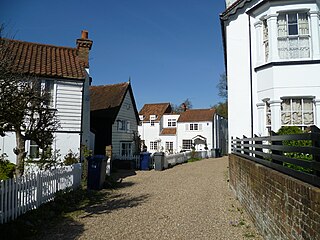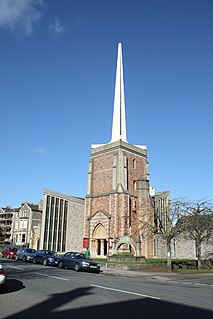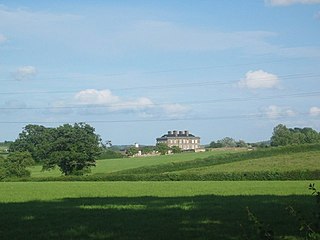History
In 1679 James Ravenscroft, a wealthy benefactor in Barnet, conveyed by deed 3½ acres of land at Stebenheath, now Stepney, to the Chancel Estate Trustees – a group of representatives of each of the churches in the local Parish who were entrusted with the Ravenscroft Estate. Ravenscroft proposed that the land should be sold to raise funds to help maintain Ravenscroft Chapel – a chapel he had erected inside Barnet Parish Church in memory of his father, Thomas Ravenscroft, who died in 1630.
In the course of time the land at Stepney was developed and built on, and its eventual sale yielded a sum far greater than could be used for the purposes originally cited by Ravenscroft. The Chancel Estate Trustees therefore decided that the remaining funds should be used for other projects, and among those projects was Church House.
The first plans for Church House were drawn up in 1897, and building work finally commenced in 1906.
A committee to oversee the management of Church House was formed soon after the building's completion later that same year. This committee consisted of the Rector, licensed clergy, the churchwardens, a Chancel Estate Trustee, as well as three members of the Congregation of Barnet Parish Church, who were selected by the other members of the committee.
The committee oversaw the official opening of Church House on 11 February 1907.
1907–1920: Early use
At first the building was primarily for Parish use only, but it was soon made available for other functions such as weddings and dances – one of the first applicants for the hire of the hall was for six dances in aid of the Children's Hospital in Park Road, Barnet. It was agreed early on, however, that no political meetings were allowed in Church House.
In 1908 a temporary building was erected at the rear of Church House and was used by the Scout Group as their Barnet headquarters.
On March 28, 1910 the Church House Committee handed over all of Church House's accounts and inventory to the Chancel Estate.
The Chancel Estate were responsible for the management of Church House up until 1920 when, in September, the Charity Commissioners agreed that a separate charity should be set up to manage Church House. A group of Trustees of this new charity was formed. It was agreed at the time that the Trustee's group should comprise nine competent persons, including the Rector and two churchwardens – who were each to be ex officio – and six representative Trustees, of whom at least three should be women; an agreement that still stands to this day.
The building was used almost daily during the 1920s by various church organisations, including mother's meetings, King's messengers, Guild of Bell ringers, Mother's Unions, Communicant's Guild, the Ladies Working Party, and the Girls Friendly Society. Dances and Whist drives were also very popular during this period.
In the 1930s Church House was the venue for a local traders fête, which was held to help local tradesmen earn extra income during a period that was still feeling the effects of the post war recession.
1936: Extending Church House
In 1936 proposals were made to extend Church House. These proposals included the demolition of the building at the south end, and the erection of a new building in Church Passage to adjoin the Hyde Institute. It was planned that part of this new extension was to be rented out by the Barnet Library Committee, and in October 1938 the Hertfordshire County Council approved a 23-year lease. The library in fact remained in Church House premises until 1992, 54 years later.
1939–1947: The Second World War
The extension was completed in December 1939. However, due to the outbreak of the Second World War it was decided not to fit the kitchen with equipment, as it was expected that the building would be requisitioned by the military as soon as it was completed.
In January 1940, this indeed happened, and Church House was taken over by Eastern Command for use by the Royal Army Pay Corps. RAPC retained the building until October 1940, at which time the local council took control on behalf of the Ministry of Food, and turned it into a British Restaurant, which were communal kitchens set up throughout the country to help people who had been bombed out of their homes or had run out of ration coupons.
The building was finally de-requisitioned and returned to the care of the Trustees in November 1946.
During the war Church House sustained minor damage caused by bombs that had fallen nearby. Although the bomb damage itself wasn't extensive, the building was in a dilapidated state following six years of heavy use by the military and local council. As a result, the War Damage Commission agreed to help fund temporary repairs. The Reverend at the time, Revd. Ben Farrer, was also instrumental in helping to raise funds to restore Church House.
During these repairs a Social Services hut was erected at the rear of Church House, and the Scout Group decided to demolish their old “temporary” headquarters and erect a new one.
Church House was finally restored and fit for its intended use by February 1947.
Present day
Church House has been in constant use since the Second World War, and it continues to be a venue for local events such as wedding receptions, meetings, market research, children's parties, children's groups, Brownies, dancing groups, keep-fit classes, yoga, badminton, and theatre groups.
In 1989 the quality and design of Church House merited that it be designated as a Building of Architectural Interest by the Department of the Environment.
A parochial church council (PCC) is the executive committee of a Church of England parish and consists of clergy and churchwardens of the parish, together with representatives of the laity. It has its origins in the vestry committee, which looked after both religious and secular matters in a parish. It is a corporate charitable body.
A vestry was a committee for the local secular and ecclesiastical government for a parish in England, Wales and some English colonies which originally met in the vestry or sacristy of the parish church, and consequently became known colloquially as the "vestry".

Hethersett is a large village and electoral ward in the county of Norfolk, England, about 6 miles (10 km) south-west of Norwich. It covers an area of 4.22 sq mi (10.9 km2) and had a population of 5,441 in 2,321 households at the 2001 census, increasing to 5,691 at the 2011 census. In 2013 Hethersett became the first village or town in the United Kingdom to receive a Prime Minister's Big Society Award for its outstanding contribution to the Olympic legacy and sport and fitness in general.

Avenue House is a large Victorian mansion situated on East End Road in Finchley in the London Borough of Barnet.

Monken Hadley is a place in the London Borough of Barnet. An ancient country village north of Barnet, it is now a suburban development on the very edge of Greater London 11 miles (18 km) north north-west of Charing Cross, while retaining much of its rural character.

St Martin in the Bull Ring is a parish church in Birmingham, England, of the Church of England. It is the original parish church of Birmingham and stands between the Bull Ring Shopping Centre and the markets.

The Parish Church of St Helier is the parish church of the parish of Saint Helier, Jersey. It is a Church of England church, one of the twelve 'Ancient Parish Churches' of Jersey, and serves as the Island's civic church and Pro-Cathedral.

Norwell is a village and parish about 6 miles (9.7 km) from Newark-on-Trent, in central Nottinghamshire, England. The population at the 2011 census was 490. It is close to the border with Lincolnshire and the River Trent, and lies approximately 1.5 miles (2.4 km) from the A1 road and 1 mile (1.6 km) from the East Coast Main Line.

St John at Hackney is a Grade II* listed Anglican Church in the heart of the London Borough of Hackney with a large capacity of around 2,000. It was built in 1792 to replace Hackney's medieval parish church, of which St Augustine's Tower remains, at the edge of its churchyard. The church faces north towards Clapton Square, with the nearby Sutton House and Hackney Central station also accessible from the churchyard to the east and south, respectively.
The Church of St. Thomas of Canterbury is an active Anglican parish church situated in the City of Chester, in an area of the city informally known as "The Garden Quarter", a densely populated area, close to the University. The church was built in 1872, but the parish of St. Oswald which it serves is much older, dating back to about 980 AD. One of the earliest references to St. Oswald's can be found in Bradshaw's. The parish registers date back to 1580. The church is recorded in the National Heritage List for England as a designated Grade II listed building. The church is part of the diocese of Chester, the archdeaconry of Chester and the deanery of Chester. The patrons of the parish are the dean and chapter of Chester Cathedral.

Trevalga is a coastal civil parish and hamlet in north Cornwall, England, United Kingdom. The parish is bounded on the north by the Celtic Sea, on the southeast by Forrabury and Minster parish and on the west by Tintagel parish.

The Quetta Memorial Precinct is a heritage-listed Anglican church precinct in Douglas Street, Thursday Island, Shire of Torres, Queensland, Australia. The precinct comprises the All Souls and St Bartholomew's Cathedral Church, the Bishop's House, and the Church Hall. The precinct was built as a memorial to the 134 lives lost in the shipwreck of the RMS Quetta on 28 February 1890. The church was designed in 1892–1893 by architect John H. Buckeridge. It was added to the Queensland Heritage Register on 27 July 2001.

Salisbury Arts Centre is a venue for theatre, music, dance, comedy, family shows, films, exhibitions, and workshops in Salisbury, Wiltshire, United Kingdom. It is run by Wiltshire Creative, a charity which provides opportunities for members of the community to experience the arts.

The Church of St Mary the Virgin, Aylesbury, is an Anglican church of the Diocese of Oxford, in the centre of the town of Aylesbury. There is evidence of a church from Saxon times, but the present building was built sometime between 1200 and 1250, with various additions and alterations in the 14th, 15th, 19th and 20th century.

St Mary the Virgin is the Church of England parish church for East Barnet within the Diocese of St Albans. It is located on Church Hill.

St John the Baptist Church is the Church of England parish church of Chipping Barnet. It forms part of the Chipping Barnet Team Ministry, comprising St Mark's, Barnet Vale, St Peter's, Arkley and St Stephen's, Bell's Hill. It crowns the ascent up Barnet Hill, and stands at the junction of Wood Street and High Street. It is one of the few Anglican churches in Greater London to belong to the Diocese of St Albans.

The Church of All Saints is a Church of England parish church in Clifton, Bristol. The church is a grade II listed building. It is located in the Parish of All Saints with St. John Clifton in the Diocese of Bristol.

John Miles was an English businessman who was master of the Stationers Company and a director of the New River Company. He was a major landowner in Friern Barnet and Whetstone in north London in the second half of the nineteenth century and was instrumental in the development of those areas.

Kingston is an historic estate in the parish of Staverton in Devon, England. The surviving large mansion house, known as Kingston House is a grade II* listed building, rebuilt in 1743 by John Rowe, after a fire had destroyed the previous structure. The Kingston Aisle or Kingston Chapel survives in the parish church of Staverton, built by and for the use of, the successive owners of the Kingston estate.

Lutterworth Town Hall is a municipal building in the High Street in Lutterworth, Leicestershire, England. The structure, which operates as a community events venue, is a Grade II listed building.


















